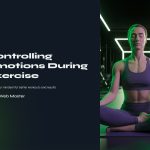 Maintaining emotional control during workouts is essential for achieving fitness goals and preventing burnout. Many people struggle with frustration, impatience, or lack of motivation, which can impact their performance and consistency. This guide will provide practical strategies to help you stay focused, manage stress, and maintain a positive mindset while exercising.
Maintaining emotional control during workouts is essential for achieving fitness goals and preventing burnout. Many people struggle with frustration, impatience, or lack of motivation, which can impact their performance and consistency. This guide will provide practical strategies to help you stay focused, manage stress, and maintain a positive mindset while exercising.

Understanding Emotional Reactions During Exercise
When engaging in physical activity, your body experiences various physiological and psychological responses. Exercise releases endorphins, which can boost mood, but it can also trigger stress due to physical exertion or unmet expectations. Recognizing the common emotional responses—such as frustration from slow progress or anxiety about performance—can help you develop effective coping mechanisms.
Common Emotional Challenges:
- Frustration: When results don’t come as fast as expected.
- Anxiety: Fear of failing or performing poorly.
- Anger: External factors like crowded gyms or distractions.
- Lack of Motivation: Feeling tired or uninspired to train.
- Impatience: Wanting instant results rather than embracing gradual progress.
By acknowledging these emotions, you can develop strategies to manage them effectively and enhance your workout experience.

Mindfulness Techniques for Emotional Control
Mindfulness is a powerful tool for managing emotions during exercise. It helps you stay present, control negative thoughts, and maximize your physical efforts.
Techniques to Implement:
- Focus on Breathing: Deep, controlled breaths can reduce stress and enhance performance.
- Body Awareness: Pay attention to muscle engagement and movement rather than distractions.
- Stay Present: Avoid overthinking results; focus on the effort you’re putting in now.
- Use Positive Affirmations: Replace negative thoughts with empowering statements.
- Practice Gratitude: Appreciate your body’s ability to move and improve.
Mindfulness creates a balanced mindset, helping you maintain motivation and emotional stability during workouts.
The Role of Music in Emotional Regulation
Music can significantly impact your mood and performance during exercise. Choosing the right playlist can enhance focus, boost energy, and provide an emotional outlet.
Tips for Using Music:
- Match Tempo to Activity: Fast beats for cardio, slower rhythms for stretching.
- Create Personalized Playlists: Select songs that inspire and motivate you.
- Use Music to Shift Mood: Play calming music when feeling anxious; high-energy beats when lacking motivation.
- Avoid Negative Lyrics: Choose uplifting, positive messages in songs.
Music is a simple yet effective way to control emotions and enhance workout enjoyment.


Setting Realistic Goals to Prevent Frustration
Unrealistic expectations can lead to disappointment and emotional distress. Setting achievable goals keeps you motivated and focused.
How to Set Realistic Goals:
- Use SMART Goals: Specific, Measurable, Achievable, Relevant, and Time-bound objectives.
- Track Progress: Keep a workout journal or use fitness apps.
- Celebrate Small Wins: Acknowledge improvements, no matter how minor.
- Adjust Expectations: Be flexible and patient with yourself.
Realistic goals foster a positive relationship with exercise and prevent unnecessary stress.

Managing Competition and Comparison
Comparing yourself to others can negatively affect your mindset. Instead of focusing on others, channel your energy into self-improvement.
Strategies to Overcome Comparison:
- Focus on Personal Growth: Measure progress against your past self, not others.
- Avoid Social Media Pressure: Limit exposure to unrealistic fitness portrayals.
- Train with Supportive People: Surround yourself with positive workout partners.
- Practice Self-Compassion: Recognize that everyone progresses at their own pace.
By shifting your focus inward, you can cultivate a healthier approach to fitness.

Using Visualization and Mental Imagery
Visualization techniques help reinforce positive emotions and enhance performance. Athletes use mental imagery to prepare for challenges and build confidence.
Visualization Strategies:
- Picture Success: Imagine completing your workout successfully.
- Create Mental Rehearsals: Visualize movements before executing them.
- Use Sensory Details: Engage all senses in your mental imagery.
- Practice Before Workouts: Spend a few minutes visualizing before starting.
This technique strengthens mental resilience, making workouts more effective and enjoyable.
Conclusion
Emotional control is just as important as physical strength when it comes to fitness. By understanding emotional triggers, practicing mindfulness, setting realistic goals, and using music and visualization, you can create a balanced and productive workout experience. The key is consistency—just as your muscles adapt and grow, so does your mental resilience. Stay patient, trust the process, and enjoy the journey toward your fitness goals.
Q&A
Q: What should I do if I feel overwhelmed during a workout?
A: Take a short break, focus on deep breathing, and remind yourself of your progress. Shifting focus to the present moment helps regain control.
Q: How can I boost motivation on days I don’t feel like exercising?
A: Listen to energizing music, set small, achievable goals, and remind yourself of the benefits of staying active.
Q: Can mindfulness improve workout performance?
A: Absolutely! Mindfulness reduces stress, enhances focus, and helps you maximize each movement, leading to better results.
*Capturing unauthorized images is prohibited*


